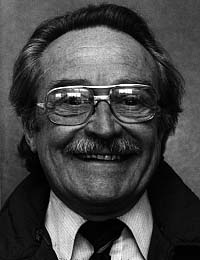
What happened after Saint-Luc and the Academy?
Andreas: Yet I hold good memories on Saint-Luc, because of the
friends and aquaintances it has left me. We shared the same passion,
we all wanted to do comics. After Saint-Luc I worked with Antonio Cossu,
Philippe Foerster and Philippe Berthet for - I don't remember exactly how long
- six to twelve months. We had rented some space and made a workshop out of it.
We had much fun. We discussed eachother's work, that was a lot of fun.
Talking to comic book artists these days, its always about rights of
authorship, contracts and the like. It's no longer about what's really
interesting about the trade.
You worked in the same space, yet everyone had his own work...
Andreas: Everyone did his own thing. We just started. I drew the
first episode of Révélations posthumes in collaboration with François Rivière
and made sketches for Eddy Paape. Antonio Cossu made drawings and the
layout for a small business magazine. Philippe Berthet and Philippe Foerster
worked on a book about hunting in Belgium; Berthet drew the animals and
Foerster did the backgrounds and characters. That was the beginning,
we became professional slowly but certainly. Then followed the first
festivals of Angoulême, where we made our first important contacts...
Andreas: That went about as follows: Paape had had a scenario from
André-Paul Duchâteau for a while. He had made some character sketches, but had
not had time to draw the story. He asked me if I wanted to sketch it.
In the beginning I wasn't fast enough for him of course: he inkted in a flash,
while it took me three days to do the sketches. He called me continuously.
That was good, because he taught me to work under pressure.
Currently I like to work fast as well to remind myself that I'm telling a story!
If you are working too long on a plate - making Le retour de Cromwell Stone I spent up
to three weeks on one plate - you seem to string standalone illustrations
together, rather than tell a story. Then you lose the feeling that you are
telling a story. I rather like to keep a certain rhythm, so that the
storyline remains clear.
--- part of article left out here ---
Andreas: We worked on Udolfo
when I moved to Paris, that was in 1978.
For Udolfo you were given a scenario. Could you decide yourself which
points of view, ways of cutting pictures, and what positioning of the characters to use?
I had the scenario of André-Paul Duchâteau, specifying on the left what happens
on each picture and on the right the dialogues, picture by picture.
But I had a lot of freedom. Eddy Paape wanted me especially for the plate
layout, the mise en scène.
That work division is remarkable, because in American comics the one
who sketches and cuts the story in pictures is credited with the drawing,
while an assistant inks all accordingly. Yet in Tintin/Hello BD (fr); Kuifje (nl) you were only
mentioned for your work on La montre aux 7 rubis in the fifth episode,
starting with page 12.
Andreas: That's possible, but it didn't really bother me. I was happy to be
doing something. I was of course very surprised when Eddy Paape asked me to
do the sketches for him! Anyway, Milton Caniff also had someone doing
the sketches for him.
Andreas: I must have one or two copies of those sketches somewhere.
I didn't draw like Paape at all, but it didn't look like Rork
either. It was just the best I could do at the time. By the way, I had to work
on a size that was too big for me. Paape then corrected the mistakes in my
drawings and inkted all, in his own way off course. He changed the characters
somewhat, added his fine lines, gave it his own style.
How was your contact with him? Did you feel at home with him?
Andreas: To me it was more about the man than about what he made.
He was an OUDE ROT IN HET VAK. The things he taught me I still use.
Simple, yet practical things. Limited, but important. From time to time
I still recall new things.
| 